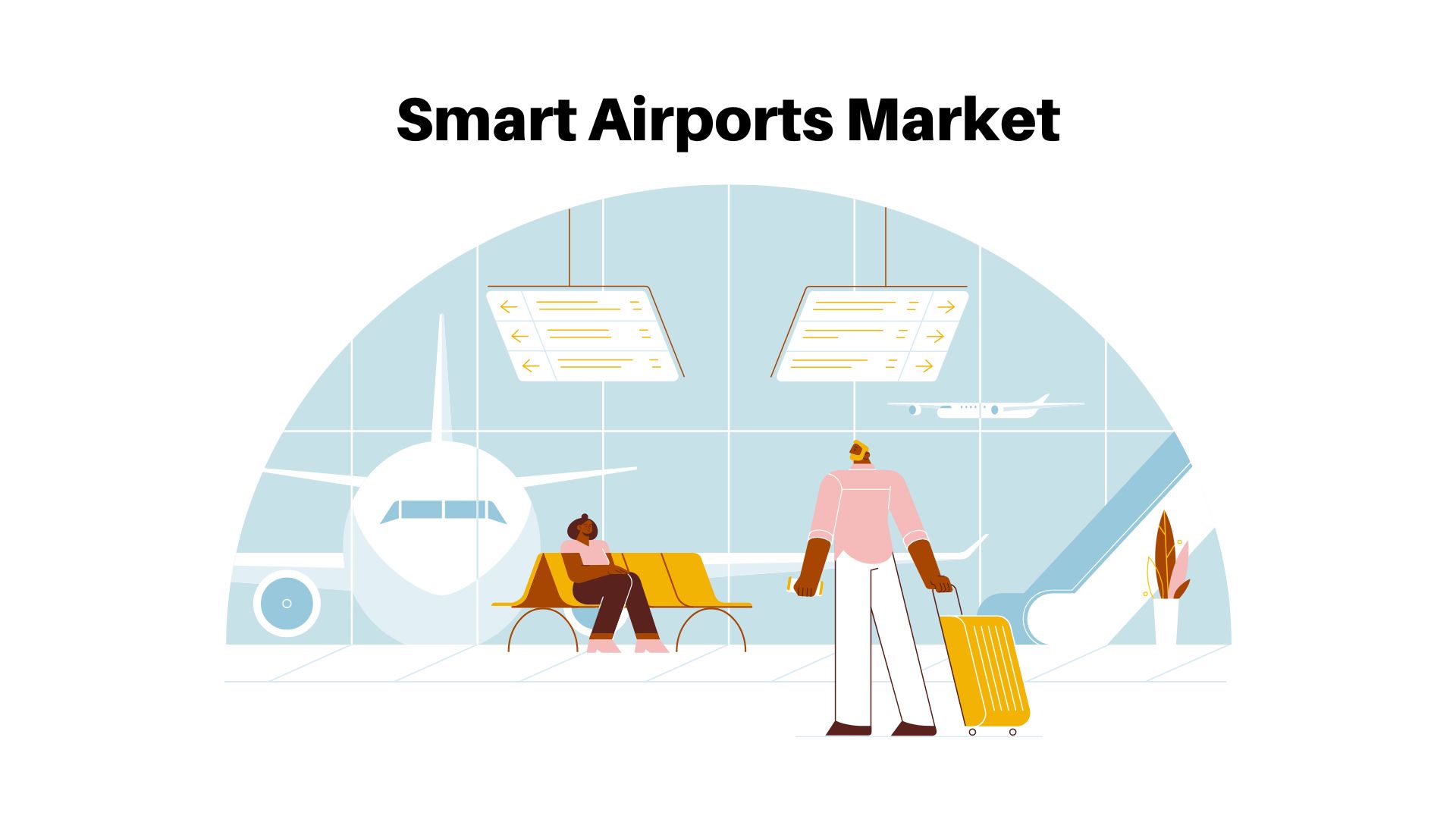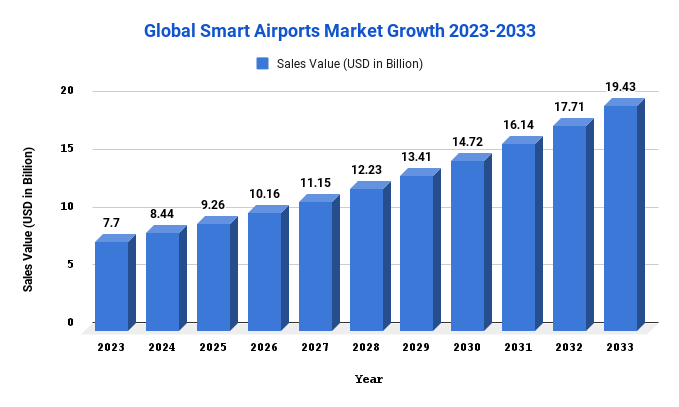Smart Airports Market is projected to reach USD 7.7 Billion by 2033 | CAGR of 9.7%

Page Contents
Market Overview
Published Via 11Press: In the coming years, global demand for smart airports is predicted to expand rapidly due to rising investments in airport infrastructure and technological advancements. At these airports, travelers can enjoy hassle-free trips with modern amenities like self-check-in terminals, biometric identity systems, and live passenger monitoring systems. North America currently leads this global market due to its quick adoption of new technologies and the presence of major companies like Honeywell International Inc., Cisco Systems Inc., and IBM Corporation; however, Asia Pacific also looks set to experience significant development within this sector due to rising air travel from countries like China and India.
The global smart airports market size is expected to grow from UЅD 7.7 Bn in 2023 to UЅD 19.4 Bn by 2033, at a CAGR of 9.7% during the forecast period.
However, factors such as high installation costs, lack of standardization across different regions, and privacy concerns could slow the growth of the smart airports market. To combat these difficulties, key players are focused on developing cost-effective solutions with enhanced security features while still respecting passenger data privacy. The smart airports market refers to the implementation of advanced technologies and innovative solutions to improve airport operations, enhance the passenger experience, and optimize infrastructure – such as biometrics, the Internet of Things (IoT), artificial intelligence (AI), robotics, etc.
Over the next ten years, demand for convenient and efficient airport services, an increase in air passengers, and cost-effective administration solutions are expected to drive growth in the market for smart airports.
Request For Sample Report Before Purchasing: https://marketresearch.biz/report/smart-airports-market/request-sample/

Key Takeaways
- The smart airports market is expected to experience significant growth over the coming years, driven by factors such as rising air travel demand, the need for efficient operations at airports, and rising technology adoption in aviation.
- The market is segmented based on technology, application, and region. Technologies include security systems, communication systems, air/ground traffic control, and passenger, cargo & baggage handling control systems. Applications span core airport operations, terminal operations, and land-side operations.
- North America is expected to dominate the market due to a number of leading vendors and the high adoption of smart airport technologies in that region. Asia-Pacific is forecasted to experience the highest compound annual growth rate (CAGR) due to increasing air traffic in countries like China and India.
- The COVID-19 pandemic has had a severe impact on the aviation industry, particularly the smart airports market. While recovery should begin gradually once the crisis ends and air travel resumes, due to its economic cost, this process may take some time due to disruption caused by the crisis.
- Smart airport technologies can improve efficiency, lower operational expenses, enhance the passenger experience, and boost revenue for airports. Thus, the adoption of these technologies is expected to surge in the coming years.
Regional Snapshot
The smart airports market is a worldwide phenomenon, with various areas embracing technology at different rates. Here is an industry overview of worldwide smart airports:
- North America has become a leader in the adoption of smart airport technologies due to major hubs like JFK, LAX, and Chicago O'Hare. The United States leads this region's smart airports market share followed by Canada.
- Europe is a leading region in the smart airports market. It boasts some of the busiest airports globally, such as Heathrow and Charles de Gaulle, fuelling demand for advanced technologies at these hubs. Furthermore, the European Union has launched initiatives to encourage airports to utilize technology more effectively which has further encouraged their adoption of smart airport solutions.
- The Asia Pacific region is expected to experience tremendous growth in the smart airports market due to increasing air traffic in countries such as China and India. Furthermore, some of the busiest airports worldwide are located here, such as Beijing Capital International Airport and Tokyo Haneda Airport.
- The Middle East has been a pioneer in adopting advanced airport technologies. Dubai International Airport boasts some of the world's most cutting-edge terminals with biometric screening and self-service kiosks installed.
- Latin America has seen an extraordinary expansion of the smart airport solutions market, particularly in countries like Brazil and Mexico. With numerous large airports such as Sao Paulo-Guarulhos International Airport and Mexico City International Airport, there is a high demand for modern solutions in this region.
Ensure everything is in line with your specific requirements here: https://marketresearch.biz/report/smart-airports-market/#inquiry
Drivers
Overall, the smart airports market is expected to experience significant growth over the coming years due to increasing air traffic, an increasing need for efficient airport operations, and technological advances.
Recently, the smart airport market experienced unprecedented growth due to technological advances, increased air traffic numbers, and an emphasis on improving customer experiences. Here are some of the primary factors responsible for this development:
Technological Advancements
Technological innovations such as the Internet of Things (IoT), artificial intelligence (AI), and automation are propelling forward the smart airport's industry. These tools are being utilized to increase operational productivity, deliver superior passenger experiences, and reduce expenses.
Growing Air Traffic
Airports are seeking ways to manage the rising number of passengers while maintaining safety and efficiency. Smart airports may provide the answer to this problem, offering improved capacity management, faster processing times, and improved communication between airlines and passengers.
Focus on Sustainability
There is an increasing focus on sustainability within the aviation industry, and smart airports are playing a leading role. They utilize green technologies to reduce energy consumption, minimize waste production, and lower their carbon footprints.
Passengers' increasing demand for personalized experiences
Airports are responding to this trend with data analytics and AI, which allow them to tailor services according to individual passengers, creating a more seamless and enjoyable journey.
Security Concerns
Security is a top priority for airports, and smart airports are employing advanced security technologies to guarantee passenger safety. These measures include biometric identification, facial recognition, and enhanced screening processes.
Partnerships and Collaborations
For smart airports to be successful, carriers, airport officials, technology suppliers, and other parties must come together. Partnerships are essential for smart airport success as they enable the creation and execution of cutting-edge technologies and services.
Overall, technological advancements, a desire for personalized experiences and an emphasis on sustainability and security are driving the smart airport industry forward. As flight travel grows more popular, smart airports will play an increasingly significant role in the aircraft business.
Restraints
The smart airports market faces several obstacles that could impede its growth and development. These barriers include:
High implementation costs
Adopting smart technologies in airports can be expensive, which may be a deterrent for smaller airports to adopt them. Additionally, retrofitting existing infrastructure to accommodate these innovations adds further to the expense.
Data Privacy and Security Issues
Smart airports collect and process vast amounts of passenger data, raising privacy and security issues. Airports must ensure that this data is collected, stored, and used in accordance with relevant regulations as well as having effective security measures in place to guard against cyber threats.
Operational Disruptions
Adopting new technologies at airports can cause operational disruptions, particularly during the implementation phase. This could cause delays and other issues that negatively impact passenger experience as well as additional costs for airports.
Limited Integration with Legacy Systems
Many airports still rely on outdated systems that may not be compatible with modern technologies, making it challenging to integrate and fully take advantage of smart technologies.
Resistant to Change
The aviation industry is known for being conservative and resistant to innovation, which can slow down airport adoption of new technologies. Resistance may come from various stakeholders such as airport management, airlines, and passengers.
Opportunities
The smart airports market is expected to grow rapidly over the coming years as airports around the world adopt new technologies for improved passenger experiences, increased operational efficiency, and enhanced safety and security measures. Here are some of the opportunities present in this space:
Enhanced Passenger Experience
Utilizing advanced technologies like biometric authentication, self-check-in kiosks and automated baggage handling systems can significantly enhance passenger experiences at airports and reduce waiting times. This is an area of focus for airports seeking to stand out in a highly competitive market.
Operational Efficiency
Smart airports can enhance operational efficiency through real-time data analytics and predictive maintenance to streamline processes, minimize downtime, and minimize delays. This could translate to significant cost savings for airports as well as airlines.
Enhancing Safety and Security
Smart airports can use advanced technologies like facial recognition, video analytics, and sensors to bolster security measures and guarantee passenger safety. This has become increasingly necessary due to global rising security concerns.
Sustainable Operations
Smart airports can incorporate green technologies such as solar power, energy-saving lighting and water recycling to reduce their carbon footprint and promote sustainability. This is becoming an increasingly important focus area for airports looking to lessen their environmental impact while meeting sustainability objectives.
New Revenue Streams
Smart airports can create new revenue streams by offering personalized services like shopping, dining and entertainment to passengers. Doing so helps the airport increase non-aeronautical revenue and reduce its dependence on airline revenues.
Overall, the smart airports market offers enormous potential for airports, airlines, and technology vendors to improve passenger experience, boost operational efficiency, and boost revenue.
Acquire Report From Here and Avail Discount – Buy the report!
Challenges
The smart airports market faces numerous obstacles that could hinder its growth and development. Some of the key obstacles include:
High Implementation Costs: One of the major obstacles facing the smart airport market is its high implementation costs. Installing sensors, systems and other technologies require a substantial investment that may be out of reach for smaller airports.
Integration Issues
One major hurdle lies in the integration of various smart systems and technologies. Many airports already have different systems in place, making it difficult to integrate new ones without disrupting the existing infrastructure. This could cause delays and extra expenses.
Cybersecurity Risks
Smart airports rely on interconnected systems and technologies, making them vulnerable to cyber-attacks. Hackers can exploit security flaws in the network to access sensitive information or even disrupt operations at the facility.
Resistance to Change
Airport staff and other stakeholders may experience resistance to change. There may be a reluctance to adopt new technologies, especially if it requires significant adjustments in existing processes and procedures.
Limited Resources
Many airports, particularly smaller regional ones, lack resources. This makes it challenging to invest in new technologies and compete with larger airports that have more resources at their disposal.
Regulatory Frameworks
The regulatory environment can pose a challenge for the smart airport market. Regulations that restrict certain technologies or limit data collection could hinder their effectiveness, negatively affecting system efficiency.
Interoperability
Lacking interoperability between different systems and technologies can present a major hurdle. This makes sharing data between systems difficult, ultimately decreasing the efficiency of smart airport solutions.
Overall, these obstacles emphasize the necessity for strategic planning and collaboration between different parties in order to overcome any remaining obstacles that stand in the way of adopting smart airport technologies.
Recent Developments
- In June 2022, Raytheon Technologies Corporation-Collins Aerospace unveiled AirPlan, an application that allows airports to manage all their resources – such as gates, check-in counters and luggage belts – through a single application on any computer or mobile device connected to their network. Through AirPlan operations can view the status of each resource at one convenient location with an intuitive user interface. Furthermore, airports now have the capacity to quickly relocate personnel, deploy ground staff members and check passengers into flights more efficiently with overall increases in customer satisfaction scores.
- In June 2022, Thales Group will release HELIXVIEW, an advanced Cabin Baggage Explosive Detection System (EDS CB) that eliminates the need for passengers to remove items from their bags. HELIXVIEW is a C3-compliant scanner (next EDS CB standard) that combines electronic scanning based on X-ray nanotechnology with 3D image reconstruction plus Thales' expertise in Artificial Intelligence (AI) and Cybersecurity into one intelligent yet cost-effective airport solution. With HELIXVIEW, travelers will experience better airport security while enjoying more convenient travel options than ever before!
- On November 2021, Honeywell International Inc. unveiled the next generation of their Honeywell NAVITAS software suite platform – a System of Systems (SoS) solution that will equip airport operators and aviation navigation service providers to make more informed and accurate decisions throughout all airside operations, from approach to the gate. These modifications enable automation and digitalization in air traffic services for efficient ground movement, situation awareness, control over ATM equipment, information management, and integration across airport operations.
- In March 2021, Thales Group unveiled a digital secondary surveillance radar with improved performance and dependability for safer air traffic management – up to 2,000 flight tracks with 64 simultaneous data outputs to air traffic centers.
Overall, the smart airports market is expected to continue growing in the coming years as airports seek to improve the passenger experience and increase operational efficiency.
Market Segmentation
Segmentation by Technology Type:
- Security systems
- Communication systems
- Passenger, cargo & baggage handling control
- Air/ground traffic control
- Endpoint Devices
- Others
Segmentation by Solution Application:
- Aeronautical operations
- Non-Aeronautical operations
Segmentation by Solution:
- Airside
- Terminal side
- Land Side
Key Companies:
- Honeywell International Inc.
- United Technologies Corporation (Collins Aerospace)
- SITA
- Siemens Aktiengesellschaft (Siemens Logistics GmbH)
- Amadeus IT Group S.A.
- NEC Corporation
- Damarel Systems International Ltd.
- International Business Machines Corporation
- QinetiQ Group Plc
- Cisco Systems Inc.
- Airport Information Systems Limited
- Pacific Controls
- ISO-Gruppe
Report Scope
| Report Attribute | Details |
| Market size value in 2023 | USD 7.7 Bn |
| Revenue forecast by 2033 | UЅD 19.4 Bn |
| Growth Rate | CAGR Of 9.7% |
| Regions Covered | North America, Europe, Asia Pacific, Latin America, and Middle East & Africa, and Rest of the World |
| Historical Years | 2017-2022 |
| Base Year | 2022 |
| Estimated Year | 2023 |
| Short-Term Projection Year | 2028 |
| Long-Term Projected Year | 2033 |
Key Questions
What are the benefits of smart airports?
Smart airports offer a range of benefits, including faster and more efficient passenger processing, reduced delays and waiting times, improved safety and security, better airport management and resource allocation, and increased revenue through improved commercial offerings.
What technologies are used in smart airports?
Smart airports use a range of technologies, including internet of things (IoT) devices, artificial intelligence (AI), machine learning, data analytics, robotics, and biometrics.
What are some examples of smart airport initiatives?
Some examples of smart airport initiatives include automated check-in and baggage handling systems, real-time passenger tracking, smart parking systems, advanced security screening, and personalized passenger services.
What is the size of the smart airports market?
The size of the smart airports market is expected to grow significantly over the next decade. According to a report by marketresearch.biz, The global smart airports market size is expected to grow from UЅD 7.7 Bn in 2023 to UЅD 19.4 Bn by 2033, at a CAGR of 9.7%. during the forecast period.
What are some key players in the smart airports market?
Some key players in the smart airports market include Honeywell International Inc., United Technologies Corporation (Collins Aerospace), SITA, Siemens Aktiengesellschaft (Siemens Logistics GmbH), Amadeus IT Group S.A., NEC Corporation, Damarel Systems International Ltd., International Business Machines Corporation, QinetiQ Group Plc, Cisco Systems Inc., Airport Information Systems Limited, Pacific Controls and ISO-Gruppe.
The team behind market.us, marketresearch.biz, market.biz and more. Our purpose is to keep our customers ahead of the game with regard to the markets. They may fluctuate up or down, but we will help you to stay ahead of the curve in these market fluctuations. Our consistent growth and ability to deliver in-depth analyses and market insight has engaged genuine market players. They have faith in us to offer the data and information they require to make balanced and decisive marketing decisions.



